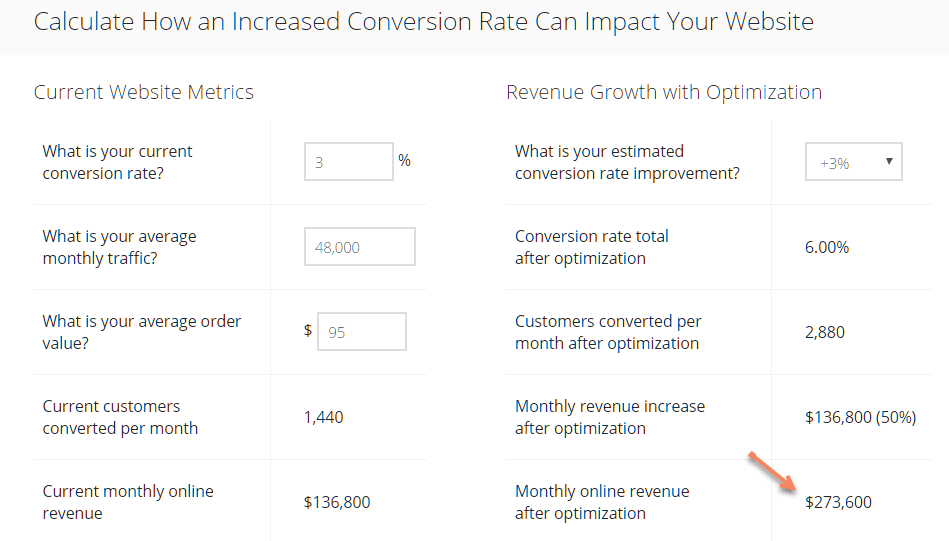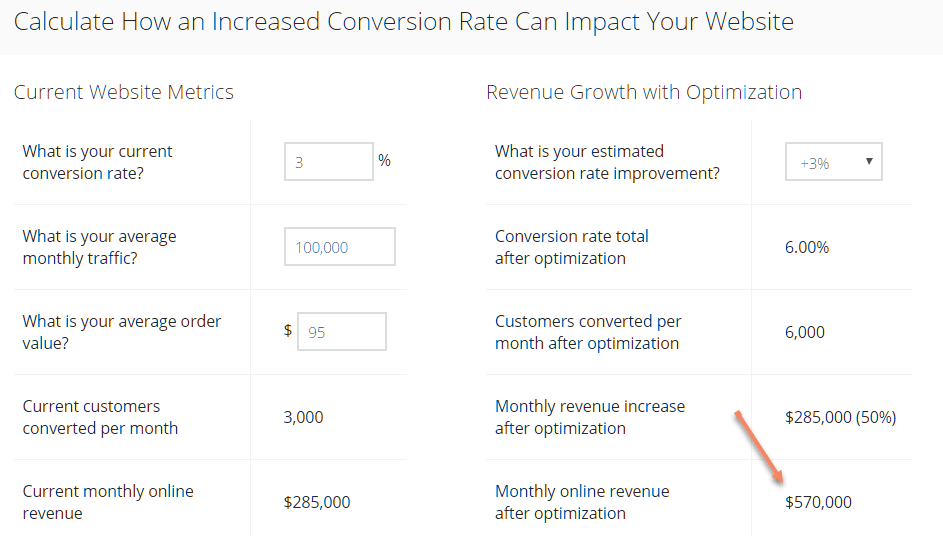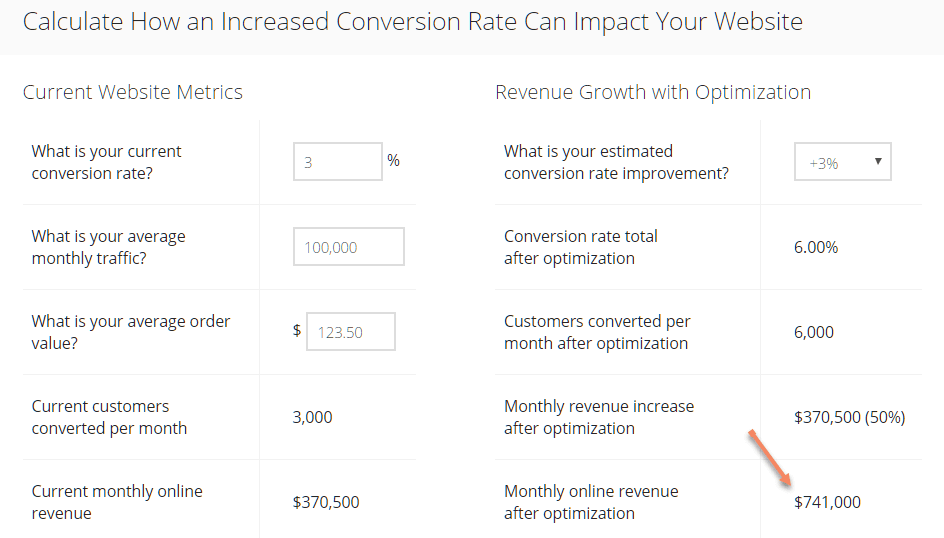
Here’s How to Triple Your Ecommerce Sales
Your conversion rate is like compound interest for your ecommerce sales. Optimize it, and you'll multiply your revenue exponentially.
Let’s say your executives have tasked you with growing your sales online.
What do you do next? What is your game plan?
What if I showed you an almost certain path to increasing your online sales but the only catch is that you’d have be patient?
The truth is we don’t have any get-rich-quick schemes for you here. But we do have a get rich steadily suggestion – one we’ve seen work over and over again.
Care to find out how to multiply the profits from your online business without selling your soul to financiers or working yourself to an early grave?
Here’s your answer. Keep reading.
Math is the poetry of logical ideas (Albert Einstein abridged)
It has often been said that compound interest is the eighth wonder of the world. It’s a mathematical miracle. Once you have money, if you use it correctly, it will go to work for you and bring home more money.
And if there’s anything sure in this wild and crazy world, it’s numbers.
How to apply the magic of compounding interest to business growth. Share on XIt stands to reason, then, that if we can find a way to apply the magic of compounding to business growth, we’ll tap into that same wonder-invoking power.
Do you agree?
Our aim here is to show you exactly how to do that. Rather than talk about it, though, we’ll show you. All it takes is a calculator. And we happen to have one right here: Conversion Rate Impact Calculator.
Take a quick look at the tool. Leave that page open so you can follow along, then join us back here. We’ll wait.
Three variables that can make a huge difference in your return on investment
We said this method is mathematical and that it can deliver results akin to those achieved by those who understand the principle of compound interest.
Let’s begin there.
The phenomenon of compounding is likened to the seven wonders of the world because it is both beautiful and immense.
Compounding interest is likened to the seven wonders of the world because it is both beautiful and immense. Share on XConsider the mind-blowing question: Would you rather I gave you a million dollars today, or a penny today – but the penny and its offspring would double in value every day for a month?
Most people, offhand, would much prefer the million bucks. Do the math, though, and you’ll find that a penny doubled daily for 30 days ends up being worth over five million dollars!
How does that happen? It’s the miracle of compounding at work. It’s as if you earn 100 percent interest every day.
Here’s how it stacks up:
Day 1: $.01
Day 2: $.02
Day 3: $.04
Day 4: $.08
Day 5: $.16
Day 6: $.32
Day 7: $.64
Day 8: $1.28
Day 9: $2.56
Day 10: $5.12
Day 11: $10.24
Day 12: $20.48
Day 13: $40.96
Day 14: $81.92
Day 15: $163.84
Day 16: $327.68
Day 17: $655.36
Day 18: $1,310.72
Day 19: $2,621.44
Day 20: $5,242.88
Day 21: $10,485.76
Day 22: $20,971.52
Day 23: $41,943.04
Day 24: $83,886.08
Day 25: $167,772.16
Day 26: $335,544.32
Day 27: $671,088.64
Day 28: $1,342,177.28
Day 29: $2,684,354.56
Day 30: $5,368,709.12
“Sure,” you may say, “that’s fine if I could figure out how to earn 100% interest daily. Fat chance of that happening, though.”
But what if your return was lower, but the time was longer? Would you end up with the same sort of progression.
Could you wait a year for that five million? How about three or five or ten years?
There’s no doubt your starting situation is important, but most of what will happen in your business over the next few years is up to what you do next.
Here are the three variables we’ll consider. You’ll note they are the fill-in fields on the calculator.
- Conversion rate
- Average monthly traffic
- Average order value
Note on the calculator that the column on the left indicates current data, and the column on the right returns changes occurring due to increased conversion rate.
Definitions of the three critical variables
We’ll briefly define our terms to make sure we’re on the same page before we begin experimenting to see what happens as we make changes to those variables.
Conversion rate: There are many conversion points you can move and measure in ecommerce. Click-through-rate, for instance, is a type of conversion: the prospect sees your link, wants to know more, and clicks the link.
For our purposes here, though, we’re talking about the most sought-after conversion of all: the visitor becomes a buyer. Here’s the formula we use for that conversion:
Conversion Rate Percentage = Number of Sales ÷ Number of Unique Site Visitors X 100
Tracking the metrics can get quite complicated quickly. That’s why many businesses fear to tread here.
In general, don’t worry about what happens if someone ‘clears their browser cache’ and deletes cookies. We don’t need an exact number. A good approximation is fine.
- By “sales” we mean the total number of sales, regardless of dollar value. If a visitor purchases a hat, that’s a sale. If another visitor buys a boat, that’s another sale. If someone else buys both a hat and a boat, that’s a sale. All get the same tally: one sale.
- By “unique site visitors” we mean each visitor is counted once (during the period being measured), even if that person returns numerous times. How do you know how many times someone returns? Your analytics program code will install a ‘cookie’ (unique identifier) on your website that tracks and analyses visits.
One thing you definitely want to do is adjust your analytics to ignore visits from robots, spiders, crawlers, and any other name you want to call the mechanized visitors that visit your site regularly to pull or scrape data.
Average monthly traffic: This metric is calculated by dividing the total unique visits (minus robots and other filtered traffic) for one year by 12. Of course, you could also divide three months of visits by three.
Here, again, we’re not looking for an exact head count. We just need to get as close as we can. The longer period we use, and the better job we do of filtering our analytics, the closer this number will be to the money.
Average order value: Total value of all orders divided by the total number of orders gives you average order value (AOV). It’s simple arithmetic, but it’s a powerful figure many companies fail to monitor. Small upticks in AOV can make big changes in your total sales. We’ll look at that in the next section.
There’s just one thing to remember: all of these metrics should be configured for the same time period. You can dial way out to an annual or even a 10-year or more report… or you can dial down close to look at how you fared yesterday (or even how things went over the past hour).
Once you get the hang of monitoring and recording this data, you won’t want to stop. And you don’t have to. If there’s one thing we preach at The Good, it’s “always be measuring and always be testing.”
Let the magic show begin
We’re going to switch back over to the calculator now and run some numbers to observe what happens as the variables begin to move. Once again, the left column is where you enter your current data. In the right column, there’s only one variable – conversion rate improvement. Plugging your goal in there will automatically adjust the other figures.
By the way, you might wonder HOW you can move your conversion rate up the scale. We won’t discuss that in this article, but we will provide links to resources at the end of this guide. To get started, though, there’s no better way we know of than to get your free Stuck Score™ results. That’s where the “Score Your Site” link at the top right of the calculator page will take you. It’s a real eye-opener for many people. You’ll get benchmarked results from five key conversion areas… and you can’t beat the (free) price.
There’s one more thing you’ll want to note. At the bottom of the calculator, you’ll see “ROI from Conversion Rate Optimization Services.” Let’s put it this way: if I promised to give you $100 for every $10 you gave me, how many ten-dollar bills would you let go of? You’d be a fool not to go to the bank and take out a loan… right? That’s the principle here, and you’ll be amazed at the numbers you’re about ready to see appear there.
Here we go.
First, let’s establish the beginning numbers. This will be our snapshot of the business as it stands, before we begin making changes to affect the three golden variables above.
Let’s say you and I own an ecommerce website. We stumble across this guide and figure, “Hey, we want to be zillionaires and retire early. Why don’t we give this Einstein plan a try?” (By the way, we could be selling bowling balls or baby carriages – it really doesn’t matter to the math. These numbers are like gravity; they affect every business exactly the same.)
We tally up the data and arrive at the following for our online business:
- Current conversion rate: 3%
- Current average monthly traffic: 48,000 unique visits
- Average order value: $95
After we plug those numbers in, the calculator tells us we’re converting 1,440 visitors into buyers every month. Our current monthly revenue from our website is $136,800. Not bad, right? Wouldn’t it be nice to earn over 100 grand every month?
You know the problem, of course: that’s gross profit. Depending on overhead and cost of goods sold, we may be living on beans and potatoes at home.
We decide to score our site to discover stuck points™. Afterwards, we talk with the conversion rate specialists at The Good, and we discover something intriguing. It turns out that conversion rate is one of the simplest ways to boost the bottom line. Typically, it’s simpler and easier to double your conversion rate than to double your AOV or amount of traffic.
So, we’ll begin by seeing what will happen if we work with The Good to move that 3% conversion rate (CR) up to 6%. We want to leave the ‘average zone’ and move towards excellence. This may seem extreme, but doubling your conversion rate is entirely possible. In our work with Snow Peak, we were able to help push that company’s conversion rate up by 108 percent.
Here’s how the numbers stack out now:
- New conversion rate: 6%
- New conversions per month: 2,880
- New monthly online revenue: $273,600
By moving the conversion rate up just three more percent, we doubled our gross profit! Not bad for a few months work. (Yes, those three ticks in CR amounted to doubling that metric. It’s still remarkable, though, that one small move brought about a pretty sizable jump in revenue).
Here’s a screenshot of the calculator with our beginning numbers and first adjustment project reflected:

We needed only to focus on one of the three variables to double our sales volume. That felt really good, but was it cost-effective?
If you’ll plug those numbers into the calculator, then look below the calculator fields to “ROI from Conversion Rate Optimization Services,” you’ll see that even if the fee required to make that jump happen was a cool $60K, we’re still going to realize a 26:1 return on our money after the first year and a whopping 81:1 return over three years.
Not bad. Not bad at all.
Let’s keep going.
We like what we’ve seen thus far, so we ask The Good if anything can be done about traffic. Would it be possible to double that too?
It turns out that our particular situation – current volume of traffic, current lack of a concerted list-building effort, current website optimization problems that are killing us on the SERP (search engine results page) for organic traffic, our poor performance driving traffic from social media – all of that can be tweaked favourably.
We turn to the site scoring results The Good ran for us at the beginning and begin to work on stuck points. After six months of work, we sit over our morning coffee checking out last month’s stats, and we discover our traffic broke 100,000 for the first time ever!
What a thrill!
We rush to check how that has affected the rest of the trifecta of metrics we’re tracking. Conversion rate is steady at 6 percent. Our AOV remains unchanged at $95. But our monthly revenue is now $570,000 dollars! That’s about 317 percent better than our starting point.
Wow.
Not only that, but our ROI over three years shows a 170:1 advantage. For every dollar we invested in conversion optimization, we’re getting handed back $170. Now, that’s a deal we’ll take every hour of every day… no problem.
Here’s a screenshot (below) of the new results:

What do you think… would we stop there?
Heck no. We now turn our attention to average order value. Is there anything we can do about that? Our team at The Good points to the results of the lifestyle brand, Fayettechill.
Management of that company came to The Good seeking an outside perspective. They were already doing well, but wanted to do better.
Consequently, The Good’s Conversion Growth Program™ helped Fayettechill grow AOV by 17 percent. And that’s for a company that already had a strong presence and many loyal followers.
We know we have plenty of room to grow – the site score pointed that out – so we dive in again to see what happens with the numbers.
When the smoke clears, our average order value is up by a solid 30 percent. The AOV is now $123.50, and our monthly sales are pushing three-quarters of a million dollars.
Are we happy campers, or what?
Checking the three-year projection, we see a net revenue increase of over $13 million and a 221:1 return our investment in conversion optimization.
The new figures are shown below:

With a little help from The Good, we’ve grown our business from $136,800 to $741,000 in monthly online revenue. Our annual sales are now hitting almost $8.9 million.
What’s next?
The moral of the story – if you can do it once, you can do it again
We love the work we do with clients. There’s no feeling quite like knowing you’ve helped a business go from stuck in a rut to out there competing with the best. We get to see furrowed brows turn to big smiles… and we get to see that on a regular basis.
But here’s the really cool part of conversion rate optimization: It’s never ending. If you can push your conversion rate up by three percentage points, what’s to stop you from going for one more? We see it happen all the time.
If you can double the number of unique visitors to your website, why not double your traffic again? And why not dig in and find ways to make sure those visitors are pre-qualified prospects?
The sky is definitely the limit when it comes to what you can do to keep moving the ball and pushing for more and more success.
It feels great.
How can that happen for you?
It can begin by getting your complimentary site score.
Where will you be this time next year if you don’t? Compare that to where you could be this time next year if you do.
Done right, conversion optimization isn’t trading dollars for dollars. It’s trading dollars for hundreds of dollars.
That’s a tough transaction to beat.
Recommended Resources
- What is CRO: Conversion Rate Optimization? [Infographic]
- Conversion Rate Optimization Essentials: The Master Guide
- How to Optimize Conversion Rates with Low Traffic

About the Author
David Hoos
David Hoos is the former Director of Marketing at The Good and a trusted advisor to marketing experts.